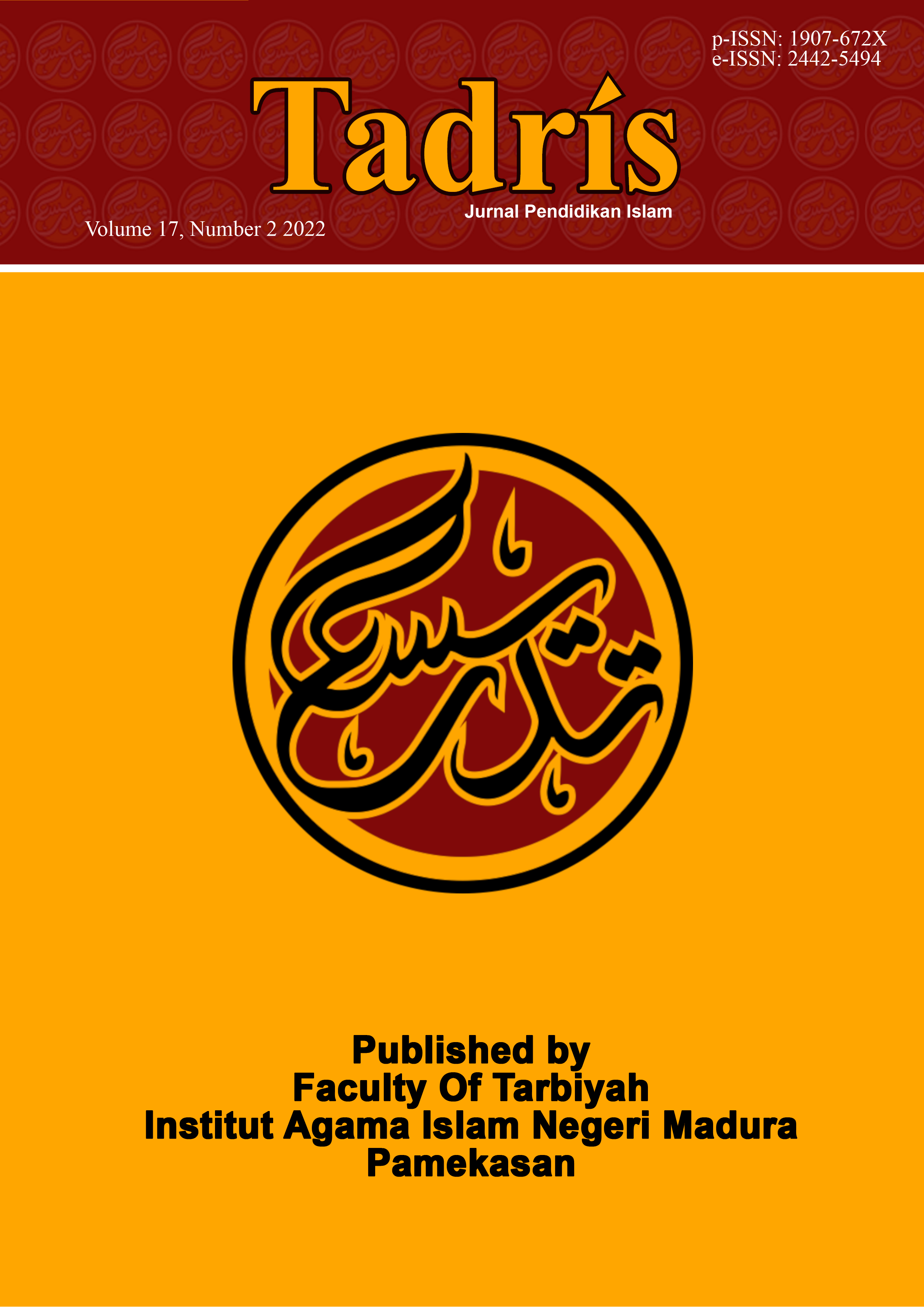The Mimicry of Shia Youths in Islamic Education and Religious Space of Education Institutions
 Abstract views: 962
,
Abstract views: 962
,
 PDF downloads: 332
PDF downloads: 332
Abstract
This article aims to reveal the discriminatory experiences encountered by Shia youths in educational institutions and their strategies for constructing their identities, both in Islamic religious education classes and in the public spaces of educational institutions. This article is the result of a qualitative-descriptive study of five Shia youths in Jember who were recruited using the chain-referral sampling method. Data collected by life-story interviews were analyzed using interactive model (Miles, et al). This article finds that Shia youths encounter discriminatory experiences because they are required by Islamic Religious Education teachers to recite prayers such as qunut, even though they claim to be members of Muhammadiyah. The two Shia youths who imitated members of Muhammadiyah intended to avoid the practice of Nahdlatul Ulama-style prayers preferred by their Islamic Religious Education teachers. In addition, Shia youth generally do not dare to reveal their identity as adherents of Shia. A Shia youth claims to be a traditional Muslim or follower of Islam to avoid discrimination from his friends. It was also dicovered that Shia youths pretend to perform prayers according to the Sunni schools while secretly performing Shia prayers to fight for their right to worship. Mimicry performed by minority Shia youths confirms Homi K. Bhabha's image of mimicry because Shia youths use the Sunni Muslim's identity space. However, they secretly try to maintain their primordial identity as Shias so that minority Shia youths use an identity that is almost the same as that of Sunni Muslim, “but not completely the same”.
Downloads
References
Abramovich, Samuel, and Peter Samuelson Wardrip. “Can Digital Badges Strengthen Religious Ethnic-Cultural Identity in a Religious Education Setting?” British Journal of Religious Education 42, no. 3 (July 2, 2020): 338–49. doi:10.1080/01416200.2019.1626219.
Arar, Khalid, Asmahan Masry-Harzalla, and Kussai Haj-Yehia. “Higher Education for Palestinian Muslim Female Students in Israel and Jordan: Migration and Identity Formation.” Cambridge Journal of Education 43, no. 1 (2013): 51–67. doi:https://doi.org/10.1080/0305764X.2012.749391.
Ardiansyah, Mochammad Zaka. “School, Symbolic Violence, and Religious Experience of Aboge Youth.” Didaktika Religia 8, no. 1 (2020): 51–77. doi:10.30762/didaktika.v8i1.1342.
———. “Taktik Bertahan Pemuda Minoritas: Perlawanan Diam Dan Mimikri Pemuda Aboge Di Lembaga Pendidikan.” Jurnal Pendidikan Agama Islam (Journal of Islamic Education Studies) 8, no. 2 (2020): 97–114. doi:doi.org/10.15642/jpai.2020.8.2.97-114.
Asman. Interview with Asman, Shia Youth, July 15, 2022.
Atkinson, Robert. “The Life Story Interview as a Mutually Equitable Relationship.” In The SAGE Handbook of Interview Research: The Complexity of the Craft, edited by Jaber F. Gubrium, James A. Holstein, Amir B. Marvasti, and Karyn D. McKinney. Thousand Oaks: SAGE Publications, 2012.
Aufar. Interview with Aufar, Shia Youth, July 5, 2022.
———. Interview with Aufar, Shia Youth, July 15, 2022.
Bagir, Zainal Abidin, and AA GN Ari Dwipayana. “Keragaman, Kesetaraan, Dan Keadilan: Pluralisme Kewargaan Dalam Masyarakat Demokratis.” In Pluralisme Kewargaan: Arah Baru Politik Kenegaraan Di Indonesia, edited by Zainal Abidin Bagir, AA GN Ari Dwipayana, Mustaghfiroh Rahayu, Trisno Sutanto, and Farid Wijidi. Yogyakarta: CRCS UGM dan Mizan, 2011.
Bernard, H. Russell. Methods in Anthropology: Qualitative and Quantitative Approaches. Sixth Edition. Lanham: Rowman & Littlefield, 2018.
Bhabha, Homi K. The Location of Culture. London: Routledge, 1994.
Brown, Katherine E., and Tania Saeed. “Radicalization and Counter-Radicalization at British Universities: Muslim Encounters and Alternatives.” Ethnic and Racial Studies 38, no. 11 (2015): 1952–68.
Christiani, Tabita Kartika. “The Future of Religiosity Education in Catholic Schools in Yogyakarta, Indonesia.” South East Asia Research 22, no. 4 (December 2014): 525–40. doi:10.5367/sear.2014.0233.
Connley, Aleah. “Understanding the Oppressed: A Study of the Ahmadiyah and Their Strategies for Overcoming Adversity in Contemporary Indonesia.” Journal of Current Southeast Asian Affairs 35, no. 1 (April 2016): 29–58. doi:10.1177/186810341603500102.
Darman. Interview with Darman, Shia Youth, July 21, 2022.
Farikhatin, Anis. “Berhadapan Dengan Prasangka: Merespons Isu Sesat Ahmadiyah Terhadap Sekolah PIRI I Yogyakarta.” In Mengelola Keragaman Di Sekolah: Gagasan Dan Pengalaman Guru, edited by Suhadi, Linah Khairiyah Pary, Fardan Mahmudatul Imamah, and Marthen Tahun, 1–15. Yogyakarta: CRCS, 2016.
Finke, Roger, Robert R. Martin, and Jonathan Fox. “Explaining Discrimination against Religious Minorities.” Religion and Politics Section of the American Political Science Association 10, no. 2 (2017): 389–416.
Gilead, Yona. “School’s Place in Nurturing Students’ Jewish Identity Within a Broader Social and Cultural World: Stakeholders’ Experience.” Journal of Jewish Education 86, no. 3 (July 2, 2020): 321–57. doi:10.1080/15244113.2020.1727305.
Gross, Zehavit, and Suzanne D. Rutland. “Creating a Safe Place: SRE Teaching as an Act of Security and Identity Formation in Government Schools in Australia.” British Journal of Religious Education 38, no. 1 (January 2, 2016): 30–46. doi:10.1080/01416200.2015.1025699.
Hakam. Interview with Hakam, Shia Youth, July 21, 2022.
Handayani, Puji. “Kebijakan Sekolah Untuk Mengantisipasi Diskriminasi Minoritas Di SMAN 1 Muntilan.” In Mengelola Keragaman Di Sekolah: Gagasan Dan Pengalaman Guru, edited by Suhadi, Linah Khairiyah Pary, Fardan Mahmudatul Imamah, and Marthen Tahun, 87–97. Yogyakarta: CRCS, 2016.
Harsono, Andreas. “Aku Ingin Lari Jauh: Ketidakadilan Aturan Berpakaian Bagi Perempuan Di Indonesia.” Human Rights Watch, 2021. https://www.hrw.org/id/report/2021/03/18/378167.
Homi K. Bhabha. Tentang Mimikri. Translated by Saut Pasaribu and Tia Setiadi. Yogyakarta: Circa, 2021.
Jeldtoft, Nadia. “Lived Islam: Religious Identity with ‘Non-Organized’ Muslim Minorities.” Ethnic and Racial Studies 34, no. 7 (July 2011): 1134–51. doi:10.1080/01419870.2010.528441.
Kevin, Fosnacht, and Cynthia Broderick. “Religious Intolerance on Campus: A Multi-Institution Study.” Journal of College and Character 21, no. 4 (2020): 244–62.
Lacan, Jacques, and Jacques-Alain Miller. The Four Fundamental Concepts of Psychoanalysis. The Seminar of Jacques Lacan, Book XI. New York: W.W. Norton & Company, 1998.
Lunneblad, Johannes, Ylva Odenbring, and Anette Hellman. “A Strong Commitment: Conforming a School Identity at One Compulsory Faith School in a Disadvantaged Area.” Ethnography and Education 12, no. 1 (2017): 112–26.
Majumdar, Samirah, and Virginia Villa. “In 2018, Government Restrictions on Religion Reach Highest Level Globally in More Than a Decade: Authoritarian Governments Are More Likely to Restrict Religion.” Pew Research Center, 2020.
Ma’rifah, Indriyani. “Belajar Islam Inklusif Dari Bangku Sekolah: Menilik Inovasi Pembelajaran Pendidikan Agama Islam Di SMA Budi Mulia Dua Yogyakarta.” In Mengelola Keragaman Di Sekolah: Gagasan Dan Pengalaman Guru, edited by Suhadi, Linah Khairiyah Pary, Fardan Mahmudatul Imamah, and Marthen Tahun, 73–85. Yogyakarta: CRCS, 2016.
Marshall, Paul. “The Ambiguities of Religious Freedom in Indonesia.” The Review of Faith & International Affairs 16, no. 1 (January 2, 2018): 85–96. doi:10.1080/15570274.2018.1433588.
Menteri Agama Republik Indonesia. Peraturan Menteri Agama Nomor 16 Tahun 2010 tentang Pelaksanaan Pendidikan Agama (2010).
Miles, Matthew B., A. Michael Huberman, and Johnny Saldana. Qualitative Data Analysis: A Methods Sourcebook. Third Edition. Thousand Oaks: SAGE Publications, 2014.
Munir. Interview with Munir, Shia Youth, July 15, 2022.
———. Interview with Munir, Shia Youth, July 16, 2022.
Natsir, Ahmad. “Identitas Poskolonialisme Pesantren Modern.” Cendekia: Jurnal Kependidikan dan Kemasyarakatan 17, no. 2 (November 5, 2019): 203–18. doi:10.21154/cendekia.v17i2.1549.
Office of International Religious Freedom. “2021 Report on International Religious Freedom.” U.S. Department of State, 2021. https://www.state.gov/reports/2021-report-on-international-religious-freedom/.
Presiden Republik Indonesia. Peraturan Pemerintah Nomor 55 Tahun 2007 Tentang Pendidikan Agama dan Pendidikan Keagamaan (2007).
Raihani, Raihani. “Minority Right to Attend Religious Education in Indonesia.” Al-Jami’ah: Journal of Islamic Studies 53, no. 1 (2015): 1–26. doi:10.14421/ajis.2015.531.1-26.
Sekretariat Negara Republik Indonesia. Undang-Undang Nomor 20 Tahun 2003 tentang Sistem Pendidikan Nasional (2003).
Stubbs, Benjamin B., and Margaret W. Sallee. “Muslim, Too: Navigating Multiple Identities at an American University.” Equity & Excellence in Education 46, no. 4 (2013): 451–67.
Suwaed, Muhammad, and Nohad Ali. “Education, Identity, and Ideology: The Islamic Movement and Moslem Religious Education in Israel.” Social Identities 22, no. 4 (July 3, 2016): 426–49. doi:10.1080/13504630.2015.1128811.
Syafi’i. “Politik Pendidikan Agama Di Sekolah: Studi Tentang Polemik Pendidikan Agama Dalam UU No.20 Tahun 2003 Tentang Sistem Pendidikan Nasional.” Dissertation, Universitas Islam Negeri Syarif Hidayatullah, 2020.
Wahid, Yenny Zannuba, Mujtaba Hamdi, Aniq HT, Libasut Taqwa, Subhi Azhari, and Gamal Ferdhi. “Laporan Tahunan Kemerdekaan Beragama/ Berkeyakinan (KBB) Tahun 2019 Di Indonesia: Kemajuan Tanpa Penyelesaian Akar Masalah.” Jakarta: Wahid Foundation, July 2020.
Wheatley, Lance. “Resisting Islamophobia; A Young Muslim Male’s Experience in a US Public High School.” Religion & Education 46, no. 3 (2019): 297–323.
Copyright (c) 2022 TADRIS: Jurnal Pendidikan Islam

This work is licensed under a Creative Commons Attribution-NonCommercial 4.0 International License.
The journal operates an Open Access policy under a Creative Commons Non-Commercial 4.0 International license. Authors who publish with this journal agree to the following terms:
- Authors retain copyright and grant the journal right of first publication with the work simultaneously licensed under a
 Commons Attribution-NonCommercial 4.0 International License
Commons Attribution-NonCommercial 4.0 International Licensethat allows others to share — copy and redistribute the material in any medium or format, and adapt — remix, transform, and build upon the material.
- Authors are able to enter into separate, additional contractual arrangements for the non-exclusive distribution of the journal's published version of the work (e.g., post it to an institutional repository or publish it in a book), with an acknowledgement of its initial publication in this journal.
- Authors are permitted and encouraged to post their work online (e.g., in institutional repositories or on their website) prior to and during the submission process, as it can lead to productive exchanges, as well as earlier and greater citation of published work (see The Effect of Open Access).














